The week at a glance
- Baillon's Crake in Co. Wexford
- Scops Owl on Scilly
- Red-flanked Bluetail in Co. Cork
- Common Yellowthroat still in Gwent, with Short-toed Eagle reported there
- Northern Waterthrush still on Scilly
- Widespread arrival of early spring overshoots and migrants
What a beautiful week it has been! Much of Britain and Ireland has been basking under big blue skies throughout, with temperatures surpassing those recorded across much of southern Europe and, quite remarkably, even Cairo at one point! Northeast Scotland boasted the warmest conditions, with Aboyne (Aberdeenshire) breaking the all-time Scottish record temperature for March on Tuesday as it recorded a ridiculous 23.6°C. It was therefore no surprise that spring really sprung this week, with juicy overshoots piling in to southern and western areas, uninhibited by clear skies and light winds stretching right up from the Mediterranean.
As it is a fortnight shy of 154 years since the last Irish record, it would be an understatement to say that the magnificent Baillon's Crake on Great Saltee Island (Wexford) on 24th was an overdue occurrence. Fortunately, the bird was found fairly early in the day and news spread quickly, allowing many Irish to make the trip southeast and see the bird during the afternoon. As is typical with the species, it was really rather fearless as it bewilderingly hustled around among bracken, stone walls and farm machinery. Needless to say, lack of suitable habitat and a clear night ruthlessly combined to deny Sunday twitchers, including one or two brave British souls who made the dash across the Irish Sea only to be disappointed by the crake's overnight disappearance.
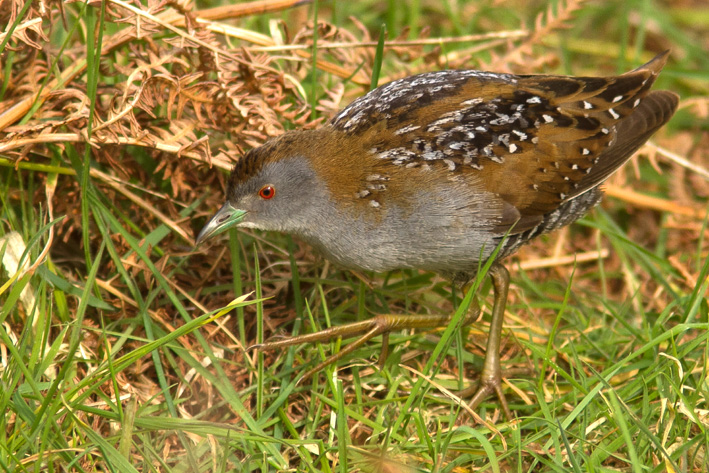
Baillon's Crake, Saltee Islands, Wexford (Photo: Tom Shevlin)
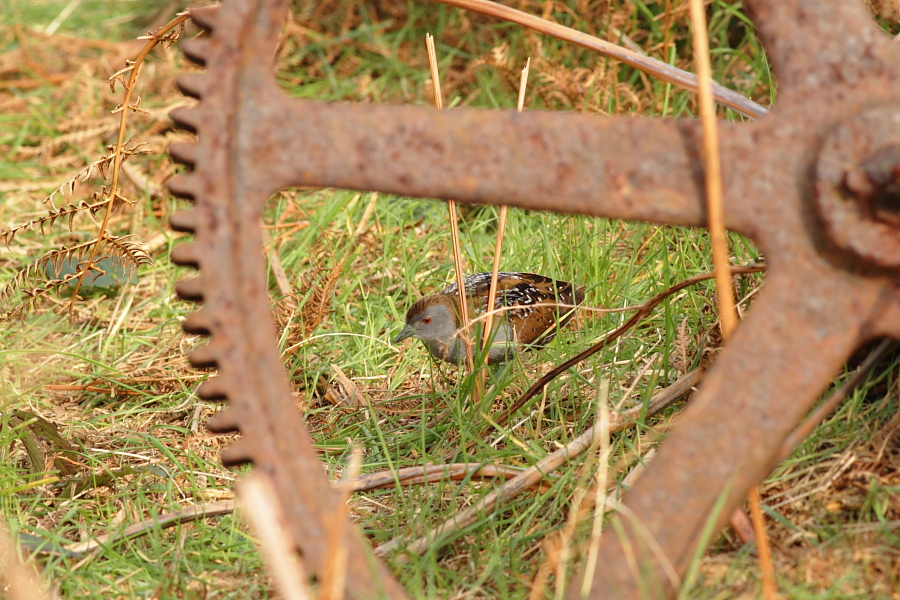
Baillon's Crake, Saltee Islands, Wexford (Photo: Dermot Breen)
We prophesized last week that something a little more exciting than a Little Bunting might come from the east in the near future; Ireland wasted no time in scoring a splendid female Red-flanked Bluetail, a one-day wonder at Galley Head (Cork) on 26th. Despite being something of an expected autumn occurrence in Britain these days, spring records are still pretty rare here. So the March date of what is only Ireland's third national record (following autumn birds in 2009 and 2010) is particularly noteworthy.

Red-flanked Bluetail, Galley Head, Cork (Photo: Tom Shevlin)
Thanks to the returning Oxfordshire individual of 2006–7, Scops Owl is not the monster bird it once was. However, a (silent) bird on St. Mary's (Scilly) on 25th was a fantastic find, although it proved most elusive and soon melted away into the dense thickets of Higher Moors. It was seen again briefly in flight the following evening, but never gave itself up in the style of the Porthgwarra (Cornwall) bird of 2002.
The male Common Yellowthroat at Rhiwderin (Gwent) was still showing well on and off throughout the week, although it was upstaged by an exciting report of an adult Short-toed Eagle drifting southwest over the site during the afternoon of 26th. Anticipation rose amid claims that photos were taken, but they subsequently failed to appear (though photos of a pale Common Buzzard from the site did). Unfortunately, it appears another report of this striking species is destined to fall by the wayside.
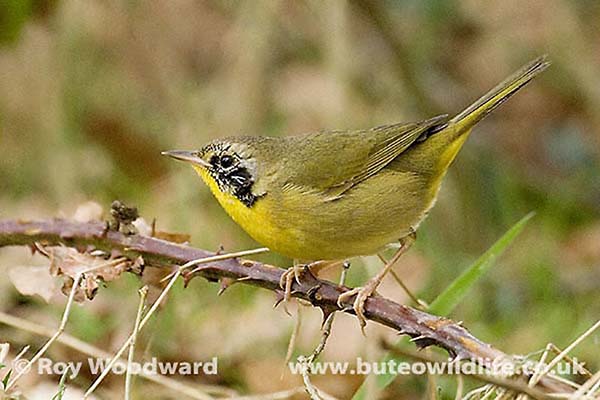
Common Yellowthroat, Rhiwderin, Gwent (Photo: Roy Woodward)
Back down on Scilly, the Northern Waterthrush was still bobbing around the stagnant pools of Lower Moors, St. Mary's for much of the week. Despite regular reports, it still appears it is difficult to catch up with: some dipped from the mainland over the weekend.
Northern Waterthrush, St. Mary's, Scilly (Video: scillypelagics)
Receiving less attention this week was Hampshire's Spanish Sparrow, which was present to 23rd only: there was negative news following a long search up until mid-afternoon on 24th. Perhaps he has struck lucky with a local lady and moved off to find a suitable nest site? Wherever he may be, it seems there is a fair chance he'll be back next winter. Confirmation also came this week that there had been no sightings of the nearby Dark-eyed Junco since 11th.
The white-morph Ross's Goose was still with Pink-footed Geese at Carnwath (Clyde) on 22nd and 25th, touring a few nearby sites on dates in between. The blue-morph Snow Goose was again seen on Tiree (Argyll) on 22nd and 26th, with the white morph still at Douglas Water (Clyde) all week and seven white morphs popping in at Slimbridge (Glos) on 27th — the same flock as last year?!
Single Richardson's Canada Geese were still on Tiree and Islay (Argyll) during the week, and the Somerset individual moved to Chew Valley Lake on 25th. At Slimbridge, a Cackling Canada Goose spent the week with local Canadas; presumably it is the bird from Gwent earlier in the winter. Red-breasted Geese remained at Southerness Point (Dumf & Gall) to 22nd and Old Hall Marshes (Essex) to 27th while, curiously, all three Black Brant records came from Ireland: birds were at Wexford Wildfowl Reserve on 25th, and Lurgan Green (Louth) and Ventry (Kerry) on 28th.

Cackling Canada Goose, Slimbridge WWT, Gloucestershire (Photo: James Lees)
In Dublin, a female Blue-winged Teal was a good find on the Skerries on 28th; the Cornish bird remained at Amble Marshes. New drake Green-winged Teal pitched up at Minsmere (Suffolk) on 25th, Dunfanaghy New Lake (Donegal) on 27th and Crookfoot Reservoir (Durham) on 28th, with lingering birds still at Loch Gruinart, Islay (Argyll), Mersehead (Dumf & Gall), Dorman's Pool (Cleveland) and Tacumshin (Wexford). The three American Wigeon were all lingering drakes at Bay of Suckquoy (Orkney), Angler's Country Park (W Yorks) and Rahasane Turlough (Galway).

American Wigeon, Anglers CP, West Yorkshire (Photo: Edward Wiper)
The drake Lesser Scaup was still on St. John's Loch (Highland), with others still at Chew Valley Lake (Somerset) to 23rd and Cardiff Bay/Cosmeston Lakes (Glamorgan) to 27th. In addition, the female was reported from Slimbridge all week. Last year it stayed in to May but, now it is an adult, perhaps hormones might kick in a little earlier this time around? Three new drake Ring-necked Ducks in Ireland were on Lough Derg (Tipperary) on 27th, and at Dunfanaghy and Inch Island Lakes (both Donegal) on 25th and 27th respectively. A couple of British records involved continuing drakes at Fleetwood (Lancs) and Par Beach Pool (Cornwall).
Two drake King Eiders were new this week: a drake on the Ythan Estuary (Aberdeenshire) from 27th is presumably the returning bird, while another was found and photographed by Belgian birders at Kintradwell (Highland) on 24th. Numbers of Surf Scoters in Colwyn Bay (Conwy) varied through the week, peaking at an excellent five (four drakes) on 26th. A drake was again off Ruddon's Point (Fife) on 26th, with others remaining off Morfa Nefyn (Gwynedd), Mount's Bay (Cornwall) and Garretstown (Cork).
Right on cue, the first White-billed Diver appeared off Port Skigersta, Lewis (Outer Hebrides) on 22nd, joined the following day by two further birds; all three were still present to 26th at least. Another individual drifted north past North Ronaldsay (Orkney) on 27th.
Following the dispersal of the mini-flock at nearby Woolacombe, Devon Night Heron records from Yelland on 25th and Wrafton on 26th probably involve the same birds. The adult was again near St. Ives (Cornwall) on 24th–25th, while the precursor to the recent arrival, the adult at Kenidjack Valley, was still present all week, being joined by a new first-summer on 28th. Never far behind are Purple Herons, with birds at Blackditch (Wicklow) on 23rd–27th, St. David's (Pembrokeshire) on 27th and Seafield (Waterford) on 27th–28th being expected arrivals given the weather conditions.
A couple of new Cattle Egrets appeared at Castle Espie (Down) on 23rd–25th and Bowling Green Marsh (Devon) on 27th. Of course, the former could be the Hillsborough (Down) bird relocating, although it was seen again there on 26th, and a report from Lurgan Green (Louth) on 28th clouds the numbers issue further. Others were still near Dorchester (Dorset) on 22nd, Lydney (Glos) to 26th and Theale Gravel Pits (Berks) to 28th, with one at Grouville Marsh (Jersey) being the first report from there since mid-February. At least a dozen Great White Egrets included twos at Westhay Moor/Meare Heath (Somerset) and Warton Marsh (Lancs), with another in Ireland at Lurgan Green (Louth) on 26th.
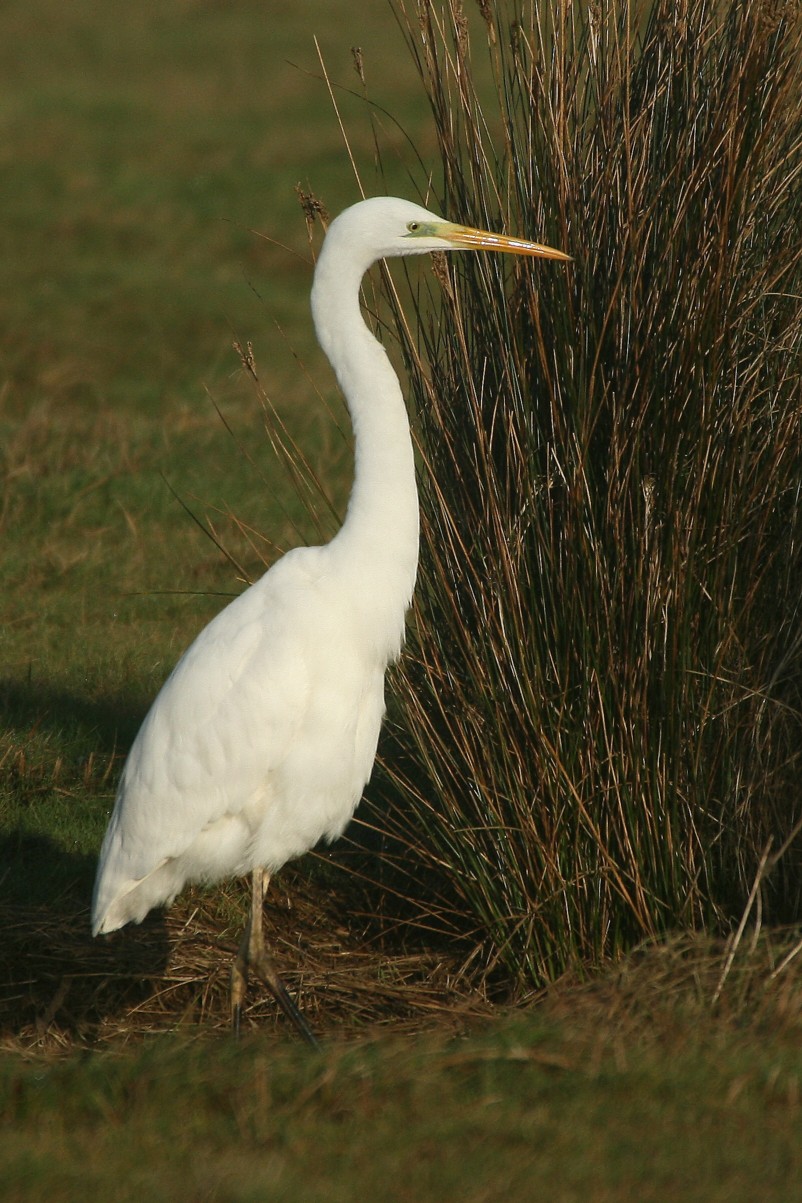
Great White Egret, Campfield Marsh RSPB, Cumbria (Photo: Sam Northwood)
A report of five White Storks over Wytham Wood (Oxon) on 28th would be an impressive sight if confirmed, while two were also reported over Potteric Carr (S Yorks) on 22nd. Another toured South Yorkshire for a couple of days, before being seen over several sites in Derbyshire on 26th–27th. One over Wetheral and Houghton (both Cumbria) on 23rd–24th presumably accounts for the report at Kilsyth (Clyde) on 25th. Reports over Redruth (Cornwall) on 22nd and Wincanton (Somerset) on 25th could relate to another wide-ranging individual.
A quieter week for Glossy Ibis was headlined by an individual as far north as Balranald, N. Uist (Outer Hebrides) from 23rd with other new individuals at Great Baddow (Essex) from 24th and Morfa Madryn (Gwynedd) on 24th, the latter presumably accounting for reports from Malltraeth (Anglesey) on 25th–26th. Four were still at Cantley Marshes (Norfolk) to 26th, with three still at Marloes Mere (Pembrokeshire), two still visiting Radipole Lake (Dorset) and singletons still in Cleveland, Lancashire, Suffolk and Galway.

Glossy Ibis, Aird an Runair, N.Uist, Outer Hebrides (Photo: Steve Duffield)
Despite the Galway Pallid Harrier not being reported, Ireland still manage to dominate in the raptor stakes. A Black Kite reported at Vartry Reservoirs (Wicklow) on 24th was the first record of the spring, while a possible female Red-footed Falcon (a very early one at that!) was seen over Cape Clear (Cork) on 27th. Rough-legged Buzzards just about scraped into double figures: all of them were seen in England.
Up in Scotland, the Pectoral Sandpiper continued to show well on the pools at Dundonald Camp (Ayrshire) to 27th, while the first-winter Greater Yellowlegs was still present and correct at Loch of Strathbeg (Aberdeenshire) throughout. Back down in the southwest, Chew Valley Lake's ever-present Spotted Sandpiper was still zipping around Herriott's Pool all week, and the Lesser Yellowlegs was also still at Kingsmill Lake (Cornwall).
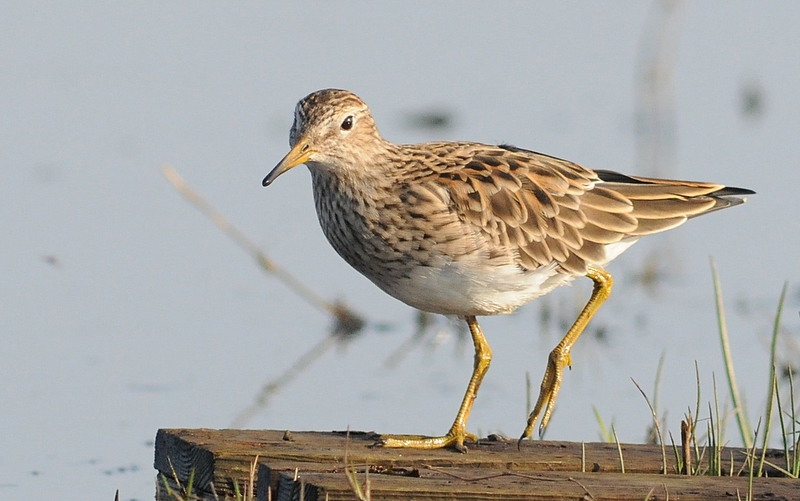
Pectoral Sandpiper, Dundonald Camp, Ayrshire (Photo: Joe Graham)
Turning to Long-billed Dowitchers: a duo of duos remained in residence. The Somerset pair were still at Meare Heath throughout the week, while two also remained around The Cull and Ballyteige Bay (Wexford). In addition, single birds were again at Wigtown (Dumf & Gall) and Kidwelly (Carmarthenshire); it's been a great winter for the species.

Long-billed Dowitcher, Shapwick Heath NNR, Somerset & Bristol (Photo: Tim Taylor)
Adult Bonaparte's Gulls were again seen at Ballygalley (Antrim) on 25th and in Cardiff Bay (Glamorgan) on 24th–26th, and the first-winter Laughing Gull was again reported from Standing Tarn (Cumbria) on 22nd. A miserable showing of just five Ring-billed Gulls included new birds at Timoleague (Cork) and flying past Newnham (Glos) on 27th, with others still at Lochgilphead (Argyll), Nimmo's Pier (Galway), and Crosby and Seaforth (Lancs).
White-winged gull numbers continued to go into freefall: the only notable count of Iceland Gulls came from Lerwick (Shetland), where around 40 birds continued throughout the week. Among them were at least three remaining Kumlien's Gulls, although there were no other significant reports from Ireland, Orkney or the Outer Hebrides. A second-winter Kumlien's, which spent the week touring various London sites, was eventually trapped and ringed during a session at Pitsea (Essex) on 24th! A widespread scattering of Glaucous Gulls also lingered on, although counts were never high.

Kumlien's Gull, Pitsea, Essex (Photo: Richard Bonser)
With the warm and sunny conditions came a sizeable arrival of Hoopoes. The first, at Sennen on 23rd, heralded the arrival of as many as 30 birds, mainly from 25th onwards. Most were in the southwest, with Cornwall claiming at least ten, as well as at least five on Scilly and three in Devon. Dorset scooped a couple on 28th, with the Isle of Wight, Glamorgan and Suffolk also claiming single birds. In Ireland, Waterford and Cork managed two apiece.

Hoopoe, Poldhu Cove, Cornwall (Photo: Seasidecottagescornwall.Co.Uk)
Two Alpine Swifts also turned up on 24th, at Fanore (Clare) and the Butt of Lewis (Outer Hebrides). Given the clear conditions, it is hardly surprising one made it to one of the most northwesterly points in Britain. A Wryneck on Bryher (Scilly) on 25th was the first of the year. The Richard's Pipit was seen again at Killard Nature Reserve (Down) on 23rd, while the Dorset individual remained at Wyke Regis. The Black-bellied Dipper was still on the River Aire in Shipley (W Yorks) on 22nd.
Common migrants continued to arrive, including some very early singing Cuckoos, a singing Grasshopper Warbler in Dorset, Pied Flycatchers in Wicklow and Devon, several Common Redstarts and Tree Pipits, and the odd Sedge Warbler among plenty of Willow Warblers and Little Ringed Plovers.
Also at Wyke Regis, the Hume's Leaf Warbler lingered on throughout the week, while a Yellow-browed Warbler at Marais Nord (Guernsey) on 28th was last noted there on New Year's Day. Others remained at Worthing (W Sussex) to 26th, Warndon (Worcs) to 27th and Exmouth (Devon) to 28th.
The first Woodchat Shrike of the spring was a timely arrival at Ardmore (Waterford) on 24th. Twenty-seven Great Grey Shrikes included a nice mix of long-staying and new birds, with 20 in England, five in Wales and two in Scotland. Of those, there were records of twos from Thursley Common (Surrey), Ibsley Common (Hants) and Pantmaenog Forest (Pembrokeshire).

Great Grey Shrike, South Leigh, Oxfordshire (Photo: Nigel Forrow)
Rose-coloured Starlings remained at Muirhead (Ayrshire) to 24th and Hordle (Hants) throughout, with the summer-like conditions no doubt aiding the former in its decision to depart its wintering site. Two Penduline Tits were belatedly reported from Minsmere (Suffolk), being present on 26th. The same day, three were reported at St. Ouen's Pond (Jersey), and had apparently already been present a week or so.

Rose-coloured Starling, Muirhead, Ayrshire (Photo: Liam Reid)
A couple of Serins also appeared: a singing male was a routine early spring occurrence on St. Mary's (Scilly) on 22nd–25th, although one over Flamborough Head (E Yorks) on 26th was more notable. Meanwhile, the Little Bunting continued to show on and off at South Milton Ley (Devon) to 27th: patience appears to be key to connecting.
So, a much more exciting week passes, with the early signs suggesting that this spring could be a productive one. In the clear conditions, western areas have dominated proceedings, but could that all be about to change as cooler, cloudier conditions roll in? Let us wait and see...
Photo of the Week: 22nd—28th March

Bittern, Mere Sands Wood LWT, Lancashire (Photo: David Moreton)
Compared to some of their more showy cousins, Bitterns are shy, skulking birds that only occasionally emerge from the cover of their favoured reed beds. This 'playing hard to get' behaviour makes any brief glimpse of these birds especially exciting. For bird photographers, though, these appearances will normally trigger a frenzy of activity as the long period of waiting suddenly turns into a brief window of opportunity to capture an image. For a close encounter, operating the camera to track the action becomes even more of a challenge. We can imagine being in David Moreton's shoes, then, as this stunning bird wrestled with a frog right in front of him! To his credit, David kept his composure and nailed a superb 'nature in the raw' action shot as the defenceless amphibian faced the gape of its captor.
Other notable photos

Lesser Spotted Woodpecker, undisclosed site, Cheshire (Photo: Steve Round)

Dipper, undisclosed site, Devon (Photo: Charlie Fleming)

Robin, Ayr, Ayrshire (Photo: Chas Moonie)

White-tailed Eagle, Japan (Photo: Andrew Moon)

Common Redshank, Salthouse, Norfolk (Photo: Carl Wright)

Gannet, Bempton Cliffs RSPB, East Yorkshire (Photo: Nick Clayton)

Long-tailed Tit, Wigan, Greater Manchester (Photo: Roy)
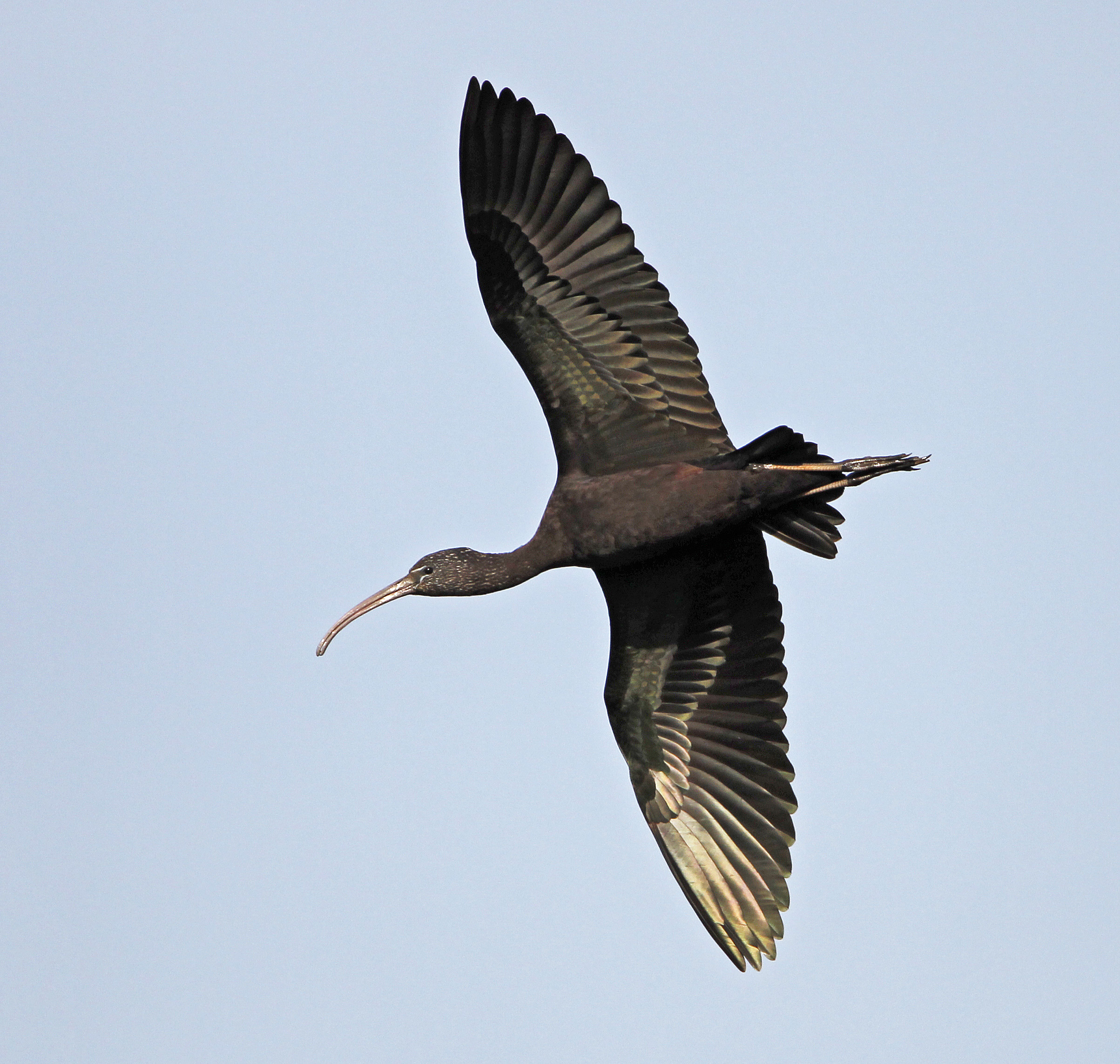
Glossy Ibis, Minsmere RSPB, Suffolk (Photo: Ian Clarke)

Water Pipit, Minsmere RSPB, Suffolk (Photo: Jon Evans)

Great Crested Grebe, Arlesey, Bedfordshire (Photo: Ben Andrew)

Skylark, undisclosed site, Cheshire (Photo: Richard Steel)
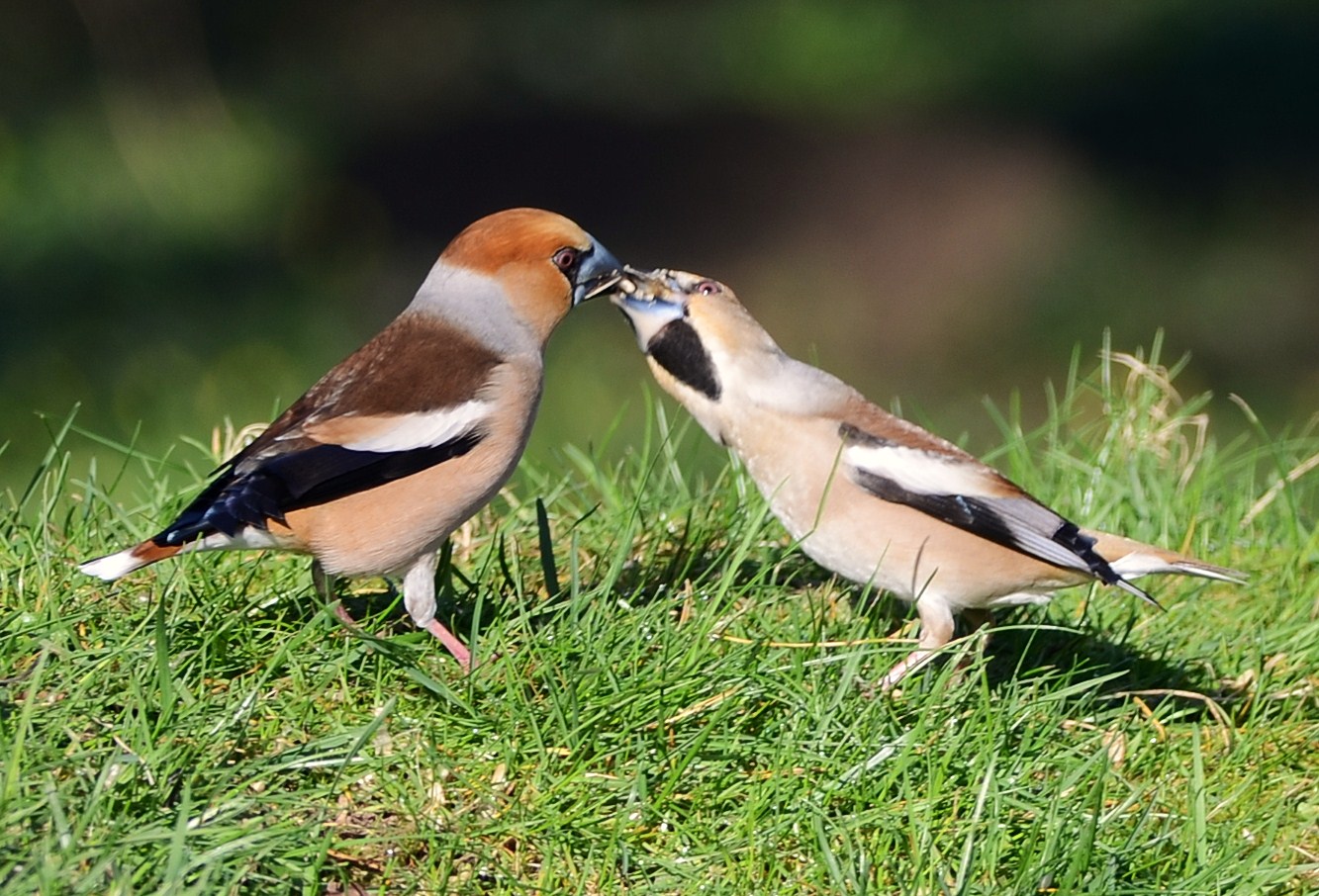
Hawfinch, Sizergh Castle, Cumbria (Photo: Morgan)

Rose-coloured Starling, Muirhead, Ayrshire (Photo: Liam Reid)

Chaffinch, undisclosed site, Clyde (Photo: Joe Graham)


